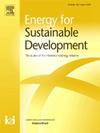氢作为清洁烹饪燃料:发展中国家的技术和经济可行性和障碍
IF 4.9
2区 工程技术
Q2 ENERGY & FUELS
引用次数: 0
摘要
每天有近30亿人使用包括木炭、木材和动物粪便在内的传统碳基能源做饭。生物质烹饪导致生物多样性丧失和森林砍伐,温室气体排放和有毒烟雾危害人类健康。通过减少室内空气污染和温室气体排放,氢可以为实现清洁和安全的烹饪做出贡献。氢模型和实验也是我们严格评估的一部分。对可再生氢技术及其在低收入国家实施的潜力进行了分析。最后,我们制定了一个不发达国家如何生产氢气的计划。正如我们在分析中所确定的那样,氢是一种安全有效的烹饪燃料。然而,有必要开发新的、创新的模式来改变传统的烹饪方法。以发展中国家为中心的氢模型应该优先采用,并考虑到欠发达国家面临的困难。此外,由于模拟的技术经济因素差异较大,在平准化能源成本(LCOE)上存在较大差异。本文对氢蒸煮技术和系统的研究现状进行了综述。它还审查了目前的建模研究,并提供了一个供发展中国家采用的概念框架。这篇综述的结论是,尽管氢烹饪技术的效率有可能达到78 - 80%,而且不会产生室内空气污染,但由于电解槽和基础设施的成本高昂,其成本仍然远远高于液化石油气和木炭。这些结果表明,为了准确预测氢的成本,使用彻底的技术经济假设是很重要的。本文章由计算机程序翻译,如有差异,请以英文原文为准。
Hydrogen as a clean cooking fuel: Technical and economic viability and barriers in developing countries
Traditional carbon-based energy sources, including charcoal, wood, and animal manure, are used for cooking by almost 3 billion people every day. Biomass cooking results in loss of biodiversity and deforestation, greenhouse gases emission and toxic smoke that compromises human health. By mitigating indoor air pollution and lowering emissions of greenhouse gases, hydrogen can contribute to the realization of clean and secure cooking. The hydrogen models and experiments are also part of our rigorous evaluation. An analysis is conducted on renewable hydrogen technologies and their potential for implementation in low-income countries. Lastly, we establish a plan for how underdeveloped nations can produce hydrogen. Hydrogen is a safe and efficient cooking fuel, as we have identified in our analysis. Nevertheless, it will be necessary to develop new, innovative models to change the traditional methods of cooking. Hydrogen models centered on the global south should prioritize adoption and account for the difficulties faced by underdeveloped nations. Furthermore, there is a large disparity in the levelized cost of energy (LCOE) because the simulations' techno-economic factors differ greatly. This paper is a review study and synthesis of the current state of hydrogen cooking technologies and systems. It also examines current modeling research and provides a conceptual framework for adoption in developing countries. This review concludes that although hydrogen cooking technologies hold the potential to reach up to 78–80 % efficiency and do not produce indoor air pollution, their cost is still considerably higher than LPG and charcoal, because of the high cost of electrolysers and infrastructure. These results demonstrate the importance of using thorough techno-economic hypotheses in order to forecast how much hydrogen cost precisely.
求助全文
通过发布文献求助,成功后即可免费获取论文全文。
去求助
来源期刊

Energy for Sustainable Development
ENERGY & FUELS-ENERGY & FUELS
CiteScore
8.10
自引率
9.10%
发文量
187
审稿时长
6-12 weeks
期刊介绍:
Published on behalf of the International Energy Initiative, Energy for Sustainable Development is the journal for decision makers, managers, consultants, policy makers, planners and researchers in both government and non-government organizations. It publishes original research and reviews about energy in developing countries, sustainable development, energy resources, technologies, policies and interactions.
 求助内容:
求助内容: 应助结果提醒方式:
应助结果提醒方式:


